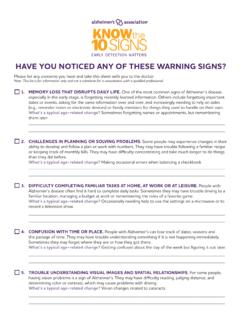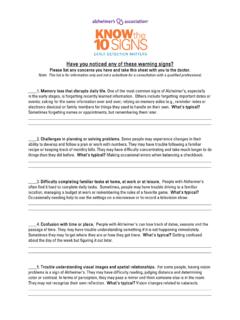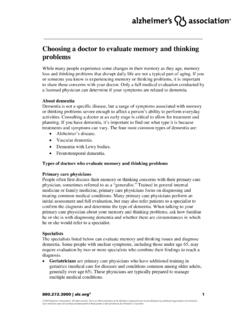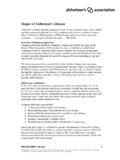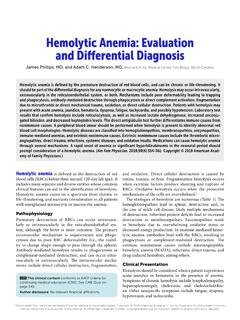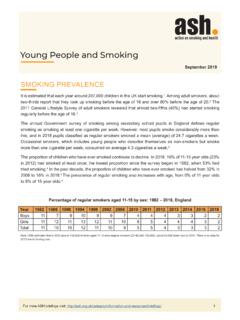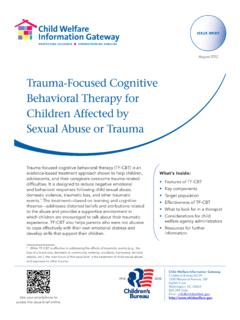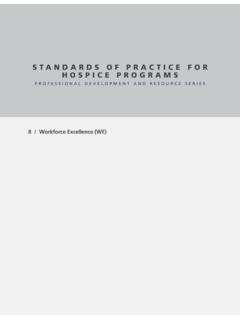Transcription of Cognitive Assessment and Care Planning Services
1 | 11 Cognitive Assessment and Care Planning Services : Alzheimer s Association Expert Task Force Recommendations and Tools for Implementation1. Background and introduction to CPT code 99483 The Alzheimer s Association has long advocated for Medicare reimbursement for Services aimed at improving detection, diagnosis, and care Planning and coordination for patients with Alzheimer s disease and related dementias (ADRD) and their caregivers (Attea, Johns, 2010). These efforts, embodied in the Health Outcomes, Planning , and Education for Alzheimer s (HOPE) Act and aided by support from physician groups involved in developing new Current Procedural Terminology (CPT) codes, culminated in approval of a Medicare procedure code, G0505, which took effect January 1, 2017. In January 2018 , G0505 was replaced by CPT code 99483. Code 99483 provides reimbursement to physicians and other eligible billing practitioners for a comprehensive clinical visit that results in a written care plan.
2 Code 99483 requires an independent historian; a multidimensional Assessment that includes cognition, function, and safety; evaluation of neuropsychiatric and behavioral symptoms; review and reconciliation of medications; and Assessment of the needs of the patient s caregiver. (See the CPT 2018 manual for full details.) These components are central to informing, designing and delivering a care plan suitable for patients with Cognitive impairment (Anonymous. Fed Register 2016). The Alzheimer s Association Expert Task Force provided information and suggestions on the content and use of Code G0505 (now 99483) to the Centers for Medicare & Medicaid (CMS) during the comment phase (Alzheimer s Association Task Force, 2016), and reconvened in November 2016 to make recommendations about how to conduct the required assessments. Its recommendations derive from a broad consensus about good clinical practice, informed by intervention trials and emphasizing validated Assessment tools that can be implemented in routine clinical care across the United States.
3 The multidisciplinary task force was comprised of geographically dispersed experts in the United States who provide ongoing clinical care for individuals with ADRD and/or have published recognized works in the field. 2. Who is eligible to receive this comprehensive care Planning service? Cognitive Assessment and care plan Services are provided when a comprehensive evaluation of a new or existing patient, who exhibits signs and/or symptoms of Cognitive impairment, is required to establish or confirm a diagnosis, etiology and severity for the not report Cognitive Assessment and care plan Services if any of the required elements are not performed or are deemed unnecessary for the patient s condition. For these Services , see the appropriate evaluation and management (E/M) code. (American Medical Association, CPT 2018 ).3. Who can provide this service? Any practitioner eligible to report E/M Services can provide this service.
4 Eligible providers include physicians (MD and DO), nurse practitioners, clinical nurse specialists, and physician assistants. Eligible practitioners must provide documentation that supports a moderate-to-high level of complexity in medical decision making, as defined by E/M guidelines (with application as appropriate of the usual incident-to rules, consistent with other E/M Services ) (Anonymous. Fed Register 2016). The provider must also document the detailed care plan developed as a result of each required element covered by with permission of the American Medical Association. (American Medical Association, 2018 Current Procedural Terminology) Copyright American Medical Association ( 2018 ). All rights | 224. What must the clinician do to meet the required elements for code 99483? Assessment of and care Planning for a patient with Cognitive impairment, requiring an independent historian, in the office or other outpatient, home, domiciliary or rest home setting with all of the following required elements: Cognition-focused evaluation including a pertinent history and examination; Medical decision making of moderate or high complexity; Functional Assessment (eg, basic and instrumental activities of daily living), including decision-making capacity; Use of standardized instruments for staging of dementia (eg, functional Assessment staging test [FAST], clinical dementia rating [CDR]); Medication reconciliation and review for high-risk medications; Evaluation for neuropsychiatric and behavioral symptoms, including depression, including use of standardized screening instrument(s); Evaluation of safety (eg, home), including motor vehicle operation.
5 Identification of caregiver(s), caregiver knowledge, caregiver needs, social supports, and the willingness of caregiver to take on caregiving tasks; Development, updating or revision, or review of an Advance Care Plan; Creation of a written care plan, including initial plans to address any neuropsychiatric symptoms, neurocognitive symptoms, functional limitations, and referral to community resources as needed (eg, rehabilitation Services , adult day programs, support groups) shared with the patient and/or caregiver with initial education and support. Typically, 50 minutes are spent face to face with the patient and/or family or caregiver. See the 2018 CPT manual for the full description and detailed instructions for code 99483. 5. When, where and by whom can the required elements be assessed? The nine Assessment elements of 99483 can be evaluated within the care Planning visit or in one or more visits that precede it, using appropriate billing codes (most often an E/M code).
6 Patients with complex medical, behavioral, psychosocial and/or caregiving needs may require a series of Assessment visits, while those with well-defined or less complex problems may be fully assessed during the care plan visit. Results of assessments conducted prior to the care plan visit are allowed in care Planning documentation provided they remain valid or are updated with any changes at the time of care single physician or other qualified health care professional should not report 99483 more than once every 180 of the required Assessment elements can be completed by appropriately trained members of the clinical team working with the eligible provider. Assessments that require the direct participation of a knowledgeable care partner or caregiver, such as a structured Assessment of the patient s functioning at home or a caregiver stress measure, may be completed prior to the clinical visit and provided to the clinician for inclusion in care Planning .
7 Care Planning visits can be conducted in the office or other outpatient, home, domiciliary or rest home What measurement tools should be used to support the care Planning process and its documentation?Standardized, validated tools are preferred whenever possible and are required for some elements (see Table 1 for suggested tools). Such tools offer a basic framework on which to build a nuanced clinical understanding of care needs through ongoing clinical contact with the patient and caregiver. Though all required elements must be represented, the choice of Assessment tools should be customized for differing clinician styles and practice composition, workflows and overall clinical goals. For example, primary care providers and dementia specialists may prefer different | 33 For several domains of care Planning , simple, validated tools do not yet exist, and where they do, not all have been formally tested for validity and uptake in actual primary care practices.
8 In the table below, those that have been tested in primary care are marked with an asterisk; those untested in primary care have either high face validity ( , Safety Assessment checklist) or published validation data that support further use. Ideally, tools should be: Practical: Time and effort to complete them fit the primary care clinical setting. Parsimonious: Provide enough information to support a meaningful care plan. Scorable: Results depicted in a single number. Retrievable: Easily incorporated into electronic health record fields and searchable at the point of care. Table 1: Suggested Measures to Support the Care- Planning Process The table below provides examples of simpler and more complex tools acceptable for assessing each domain. In some settings, a simple tool might be sufficient; in others, it could be used to trigger a more complex Assessment or be replaced by a more detailed measure.
9 DomainSuggested measuresCommentsCognitionMini-CogGPCOGS hort MoCA 3 min, validated in primary carePatient/informant components~ 5 min, needs testing in primary careFunctionKatz (ADL), Lawton-Brody (IADL)Caregiver ratedStage of Cognitive impairmentDementia Severity Rating ScaleCaregiver rated, correlates with Clinical Dementia RatingDecision-making3-level rating: able to make own deci-sions, not able, uncertain/needs more evaluationGlobal clinician judgmentNeuropsychiatric symptomsDepressionNPI-QBEHAVE 5+PHQ-210 items6 high-impact items Depression identificationMedication review and reconciliationMed list + name of person overseeing home medsIdentify/reconsider high-risk meds; assess for reliable administration by self or otherSafetySafety Assessment Guide7 questions (patient/caregiver)Caregiver identification and needs assessmentCaregiver Profile ChecklistSingle-Item stress ThermometerPHQ-2 Ability/willingness to care, needs for information, education, and supportRapid identification of stressDepression Advance care planningEnd-of-Life ChecklistScreen for preferences and legal | 447.
10 The written care planPreparing the plan The care plan should reflect a synthesis of the information acquired as part of the Assessment . It should be written in language that is easily understood, indicate who has responsibility for carrying out each recommended action step and specify an initial follow-up schedule. Some clinicians find it useful to organize the care plan into broad components, such as: Specific characteristics of the Cognitive disorder ( , type and severity of Cognitive impairment; special hazards such as falls or orthostatic hypotension in Lewy body dementia; or referral to a dementia specialist for further diagnostic Assessment or complex management ). management of any neuropsychiatric symptoms, including referrals for caregiver stress and behavior management training or psychiatric care for the patient as indicated. Comorbid medical conditions and safety management , including any changes needed to accommodate the effects of Cognitive impairment.


